This web page describes the sixth leg of the third 1997 sailing trip with S/Y Thetis in the Aegean and Eastern Mediterranean. It covers the solo sail from the Greek island of Kastellorizo to Crete. On the way we visit the remote Dodechanese islands of Karpathos and Kasos. The web page is illustrated with photographs, also included are historical and geographical descriptions of the places visited as well as several links to other related web sites.
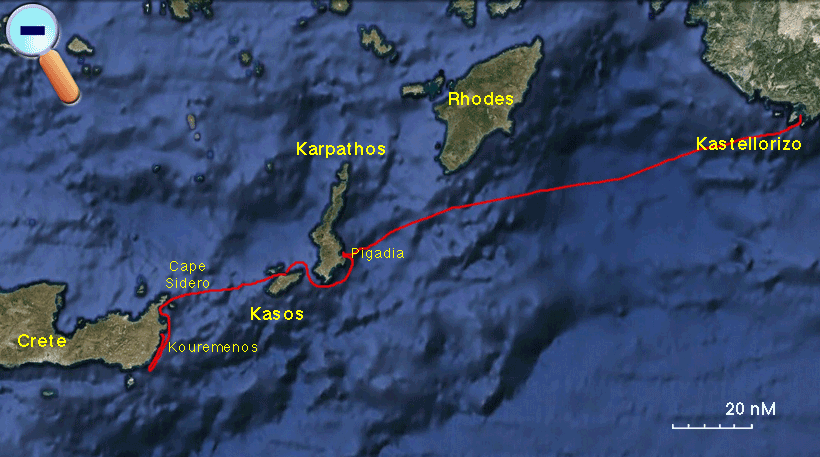
Monday September 15, 1997 Day 39
We took ashore Alice’s luggage and waited for the “airport bus” to arrive. It came a few minutes before 8:00 from where it was parked 20 m away, to the “loading area.” There were very few people. We got to the airport, checked her luggage, and waited for the plane. The tiny plane landed and actually quite a few people came out and the bus started filling to capacity. I said good bye to Alice and rushed in the bus which drove back into town.
After a few food purchases, I went on-board and stated getting ready to depart for Karpathos. A few days ago I still had not made up my mind on the return route to Athens. I had been tempted to visit Cyprus since it is not too far from Kastellorizo but seeing that there are very few natural harbors and coves I finally decided to go west to Karpathos and Crete places where I had never sailed to before. Also from Crete I could choose either to sail north via the Cyclades or to Kythera and then sail N along the more sheltered Peloponnesos coast. The Navtex weather 24 hr forecast was good: northerly 3-4 here and 4 at the Karpathos sea with an expected gradual increase from tomorrow afternoon. Just in case, I raised the zodiac onboard and lashed it. As it was very hot with no wind at all I also put up the tent. My estimate was that I could reach Karpathos in about 22 hrs.
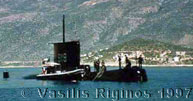
I raised the anchor at 11:30 and motored out of the harbor. The submarine was still there and I took a few pictures as I was going by. I heard the 13:00 AM radio weather broadcast from Rhodes, no new information. By this time we were 12 M from Kastellorizo and there was a slight wind, enough to unroll the genoa and motor-sail. By 15:30 the wind increased a little from the WSW and I was able to raise the main (no reefs), turn off the motor, and sail very close to the wind. There was a confused swell.
At 19:00 the wind decreased and veered to the W and I had to roll-in the genoa and motor-sail. We had covered 40 M, a third of the way. As the evening progressed the swell increased and it was hard to cook. Since my tummy had still not settled yet, I made myself some rice and a 2-egg omelet.
By 23:00 the wind had picked up and I unrolled part of the genoa and stopped the motor, we were sailing at 5 knots. The night was very pleasant with an almost full moon, although the swell kept increasing. I started sleeping for 20 minute intervals after which I checked the boat and the sea and radar for traffic and went back to sleep. We crossed paths with several ships but none too close.
Tuesday September 16, 1997 Day 40
After midnight all was going well except that the swell and the wind kept increasing steadily and veering more and more against the course to Karpathos. I rolled-in the genoa which was flapping and motor-sailed very close to the wind.
Around 3:00 the Autohelm ST-4000 autopilot tripped its circuit breaker. No matter what I did it kept tripping the circuit breaker. As I had to motor anyway and I had to also troubleshoot the autopilot, I tied down the tiller (I had a rope and small cleats specially configured for such a case) and with some difficulty managed to lower and tie down the main sail. The wind had increased to 25 knots and the waves were very large. I tested the autopilot control with the ohm meter, it was shorted so there was nothing to be done with it. I disconnected the control unit and powered the autopilot circuit with both the actuator and the fluxgate compass connected. No problem. So my conclusion was that only the control unit was damaged. I did have the old ST-2000 autopilot as a spare. However, when I inspected the boat before leaving from Glyfada its special plug was missing. No one could account for this, especially not Rohalio who takes care of the boat while she is in Glyfada. I had replaced this plug with a normal one but foolishly I had not tested the unit. Now I plugged it in and it would not work.
After one hour of hand steering the wind had increased to 30 knots with gusts to 35 (a good force 7) and there was a considerable amount of spray. I was drenched despite having already donned the storm gear. Hand steering was not difficult since with a heading of 250° I just had to aim at the moon but it was uncomfortable with the spray. The boat would not keep its course on this heading, without sails, with the tiller tied down.
I kept on hand steering with a break every hour when I would tie the tiller, and reduce the RPM or put the engine at neutral while I went into the cabin, removed the storm gear, washed my face with fresh water, and dried myself with a towel while checking the radar and the GPS. When the moon set my job became even harder since I had to pay attention to the compass which was hard to see in the spray. I put on the spray hood but one of its zippers broke and I had to find safety pins to hold it in place. This was hard with the boat rolling heavily. Unfortunately the effect of the spray hood was marginal since it did not prevent most of the spray from reaching me in the back of the cockpit by the tiller. One good thing was that the modification we did in Glyfada with the sprayhood clips was working well.
By the time of sunrise the wind had reached gale force at 37 knots (force 8) with higher gusts. The spray was constant and with the sun my eyes begun to hurt. I had an inspiration! I put on the diving mask which protected my eyes but made the watching of the compass even harder. By 8:00 the island of Karpathos was visible but the waves kept getting larger.
Finally by 11:30 and after 117.4 M we entered Pigadia (Πυγάδια) or Port Karpathos [35° 30.7' N 27° 12.8' E] in the island of Karpathos (Κάρπαθος) which had waves, just smaller then the ones one mile further out. The wind was howling. I dropped the anchor and with the use of the rear windlass control I made a perfect approach to the jetty. A nice German tourist caught my lines and tied them. I could not get too near the jetty because of the furious swell. Although I was out of the open sea, the boat was hardly safer here. The waves were coming from offshore so all that prevented Thetis from smashing on the concrete jetty was the anchor with 70 m scope which for the moment was holding, but I did not totally trust it! I launched the zodiac and prepared to deploy the second anchor and tie extra spring lines for the swell when the captain of a large fishing boat came. I asked him about local conditions. He told me that unless one’s boat is on the other side of the jetty (too shallow for Thetis) the harbor is not safe with this NW wind but just across the Pigadia bay one can anchor off-shore and it is well protected. He also told me that the forecast (I was too busy to turn on the Navtex) was calling for a further wind increase to force 9.
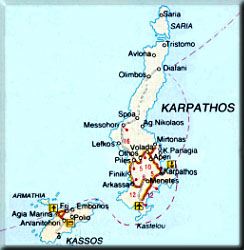
|

Pigadia Harbor |
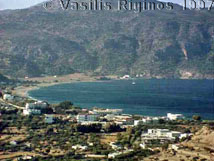
Although I was tired and wanted to make a phone call to Alice in Athens and the VHF did not receive Hellas Radio that close to the island, I decided to move. The captain helped by untying the lines, and after raising the anchor we moved 2 M north on the other side of the Pigadia Bay. Indeed it was surprisingly calm despite the fierce gusts down the Karpathos mountains, with the wind averaging 35 knots and reaching over 45 with the gusts. I anchored at 5 m depth [35° 31.5' N 27° 12.1' E] with both anchors, with 70 m scope on the primary and 50 on the secondary and the anchors at 45° from each other against the wind direction. By the time Thetis was secured to my satisfaction it was 13:30. We had traveled 119.4 M from Kastellorizo.
The bay was very attractive, despite the infernal wind. There was a long sand beach. Thetis was anchored not too far from the Greenpeace restaurant/beach with green umbrellas. I took the zodiac ashore and inquired at the restaurant for a telephone. They have no phone but not too far on the road there is a card phone. I called Alice. She had arrived in Athens without any trouble, but she had not seen my brother Byron yet, nor had she had any news from Nikos. I called the Autohelm dealership in Athens and spoke with Mr. Skordilis himself who definitely recognized me. I explained my autopilot problems and he concurred with me that the trouble must be in the control unit. He said he would look in his stock to see if he has another ST-4000 control unit, and I was to call him again in a few minutes as he could not call me back at the card phone. I went back to the restaurant, and since I was famished, I had a large glass of cold beer and a very tasty souvlaki with spinach rice and fresh fried potatoes. The people at the restaurant were very friendly and they would be glad to receive and hold any package sent to me. Back on the phone with Mr. Skordilis. He had the part, which costs 125,000 GRD, and he said he would try to ship it to the Greenpeace via a courier by evening. That was a relief.
Back on board I picked up the boat which was a mess from the long rough passage. I hung all the wet clothes and storm gear (inside because of the wind) and fell asleep. When I woke up it was evening. I ate some cheese and fruits and read a little. I received the 8:00 PM Navtex report: Gale warning, most of the Aegean will have force 7-8 and the Karpathio Sea 8. The wind meter was measuring now 38 knots with higher gusts but the boat was very steady riding over her two anchors well dug in the sand bottom.
As I was preparing to go back to sleep I noticed the moon. There was a lunar eclipse going on. Despite my sleepiness I watched in total fascination. After an hour the full moon became a dark orange globe and all the stars appeared in the pitch dark sky. It was a total eclipse with a full moon in a completely cloudless and clear sky. I have never before seen such a sight. After 1½ hour the moon started emerging ever so slowly. It was magnificent.
Wednesday September 17, 1997 Day 41
Karpathos, the Venetian Scarpanto, is one of the largest Dodecanese islands. Its highest mountain is Mt. Kalolimni at 1,215 m (3,986 ft). The island is divided by this mountain in to two almost separate parts the South with most of the fertile land and inhabitants and the much wilder and isolated North. It is in the North and especially in the village of Olympos that, because of the isolation and now for, I suspect, tourist reasons, some of the folkloric customs and costumes are preserved.
This windswept island was originally inhabited by Cretans and even today most of its trade with the outside world is via Crete and not Rhodes, the capital of the Dodecanese. A few Mycenean artifacts have been excavated near the Pigadia. In 1206 the island fell under the Frankish crusaders, to be followed by the Venetians, and the Ottomans who held it until 1912 when it and the rest of the Dodecanese were sold to the Italians. All the Dodecanese islands were joined with Greece following World War II.
The wind howled all night with strong gusts of over 40 knots. In the morning I went ashore with the zodiac and then walked 20 minutes to the town where I rented a motor bike from the Gatoulis (little cat) outfit. I did some food shopping in town. It was a pleasant enough town but with nothing special.
I drove back to the Greenpeace. There was no autopilot part waiting for me but I seriously doubt if any airplane managed to land with this wind. The lady who cooks was very pleasant and talkative. She had lived in Astoria, N.Y. for many years and both she and her brother worked in Greenwich village and at 72nd and Broadway, both being my old neighborhoods. I had lunch there: baked fish. Superb and only 3,000 GRD.
The boat was fine. She had not moved at all despite the gusts which had reached 47 knots. I snorkeled to check my anchors. They were totally buried under the sand. With the boat secured, I went ashore to practice tourism.
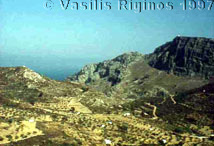
I drove north towards Aperi and Volanda. These villages have good views and are nicely situated but their houses are fairly new and nothing special. Aperi was the old capital of Karpathos. As I was heading west I came across a mystery road, not shown on my map, which I followed. It kept going higher and higher until it led me to a Greek Air Force beacon installation at one of the island’s highest peaks at 1,215 m altitude. I returned to the main road and continued west to Piles (Πυλές) and to Finiki. The surf on the west coast was considerable. Riding the motor bike was very difficult because of the wind and the cold. I returned to the boat via Arkasa and Menetes.
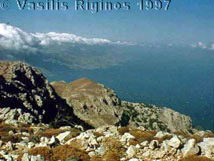
I was very dusty and cold. Alas the sun shower had not warmed any water because of the strong winds, so I could only take a cold shower. At night I ate some bread and cheese as I was not very hungry. It was also too cold to sit in the cockpit. This change in temperature from the heat in Kastellorizo just two night ago was most dramatic.
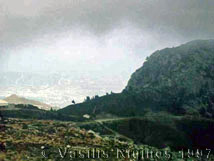
Thursday September 18, 1997 Day 42
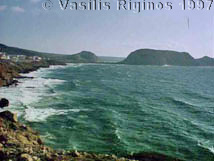
All night the wind blew on and off with strong gusts. In the morning I prepared for a motorbike expedition. Unlike yesterday, I took long pants, a pullover, and the storm jacket. I also packed a picnic lunch. Before hitting the road, I called Autohelm in Athens. They did send the part 2 days ago, as promised, and they gave me the shipping number.
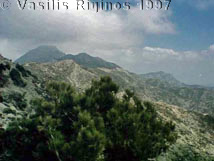
At 9:00 I rode the bike to the West and just like yesterday went via Piles and then headed north following the West coast. The sea to the left was very angry and there were many clouds on the sky. To the right there was a lovely pine tree forest. At a card phone I dialed the Faneromeni’s mobile telephone number and Nikos did answer. They are holed in Phinikas, Syros waiting for the gale to blow over, which according to a forecast they got, will not be until Saturday. Here I was experiencing very strong gusts. I continued toward Spoa. At Spoa the paved road ends. I followed the very rough dirt road leading to Olympos.
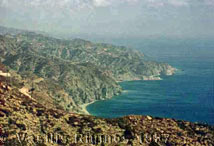
The road follows the high ridge of the island from which I could see both the East and the West coasts. The view was breathtaking and so were the gusts which threatened to blow the motorbike off the road. In many exposed spots the wind made it impossible to ride, and I had to push the bike on foot. I was scared, but I kept on pushing and riding the bike at very low speed. Despite having changed to the long pants, pullover, and storm jacket, the wind penetrated them and I was cold.
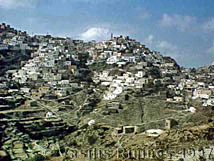
After a long time I finally saw Olympos at a distance looking like a mirage. As it was past noon I stopped and had my lunch. Instead of going to the town directly I rode down hill to Diaphani, Olympos’ harbor. The road was paved again, just from Olympos to Diaphani, but with a lot of cave-ins. All the traffic to Olympos comes by ferry boats via Diaphani and this road. This road has many hairpin turns and is very dramatic. All the trees are bent and show signs of being tortured by the relentless wind. Diaphani itself is a pleasant but hardly remarkable village.
Back on the bike I rode to Olympos. Olympos was by far the most picturesque village I had seen so far in Karpathos and in many other islands as well. It has many narrow winding streets, many with stairs. One of the streets had been spruced up and was lined with stores and restaurants for the tourists who are brought with tour busses from Diaphani. Many of the stores were tended by ladies in Karpathian costume who sold embroideries. Their laid back soft selling technique was very refreshing after the pushy hard sell in Turkey. They had several attractive designs and they were not too expensive - 7 to 10 thousand drachmas. I bought one.
I called Alice in Washington, D.C. She flew out of Athens yesterday morning as planned and was connecting for D.C. in London. There was some equipment problem with the plane out of London and it caused a 12 hr delay. But, although late, she did make it to Washington.
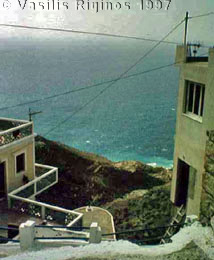
A street |
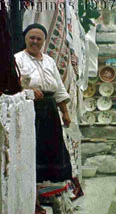
Woman in costume |
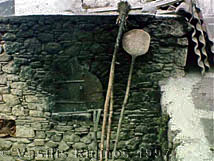
A wooden burning oven |
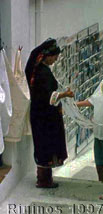
Another woman in costume |
I headed for the long drive back to the boat. I made it back to the Greenpeace by 6:00 PM. There was no package!
After I got back onboard, I drained and cleaned the bowl of the Racor fuel pre-filter which had collected a fair amount of crud. After re-assembling the filter, I started the motor and all seemed normal. I left the motor running to re-charge the batteries, and started transferring fuel from the jerry cans to the tank. After a few minutes of normal engine operation, the engine sputtered and quit. I finished with the transfer and checked the fuel intake. There was no fuel in the regular fuel filter. The lines needed bleeding. I bled them and started the engine again. It ran for over 20 minutes without any problem.
I took the empty jerry cans ashore, and drove them with the motorbike to a gas station and refilled them. I then left them in the zodiac and drove to the town. I found the courier’s office and retrieved the package with the new autopilot controller.
Back on Thetis I cooked spaghetti with tuna, capers, onion, and garlic. Either it was delicious or I was very hungry. I ate it with great gusto to the accompaniment of the last bottle of Effes beer from Turkey. The wind was not as strong, only 15-17 knots. It was a long day!
Friday September 19, 1997 Day 43
It was a quiet night. The Navtex forecast called for wind of only force 7 for the Karpathio Sea with further attenuation by the evening. It was a cloudy but warm day and less windy then the last ones, the wind meter registering less than 20 knots.
I installed the new autopilot controller and tested it. It worked fine. I then started looking at the spare auto pilot. I could not find anything wrong with it so I checked the voltage at the plug socket Bingo! The socket had the wrong polarity. It seems that the electrician had made a mistake and re-wired it wrong. I re-wired it and plugged in the spare auto pilot. It worked. Also I checked the DC to AC converter which was tripping the circuit breaker. Now with the correct polarity at the plug socket it also worked. Three problems fixed!
I took my dirty clothes ashore and drove them to a laundry in town. It was expensive at 2,150 GRD per load. Killing time until the laundry would be ready, I drove to the airport region. This is a wind surfer’s paradise. Very strong wind and very protected from the sea with no waves. Corinna would have loved it!
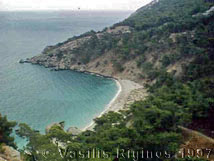
After picking up the laundry I drove to the Greenpeace, had lunch, and said good-bye to Mrs. Phaedra since tomorrow I will be leaving Karpathos.
I left the laundry in the zodiac and drove via dirt roads north in the East shore. This island is now what Samos used to be 20 years ago, uncrowded, light tourist development and plenty of totally undeveloped areas served by rough dirt roads. There is not much cultivation either. I drove near a very pleasant deserted cove, to which I went on foot, but it was too cold for swimming.
I bought 8 bottles of drinking water and ferried them to the zodiac and then I returned the motorbike and walked back. Onboard I had a snack and started preparation for sailing to Kasos tomorrow. I liked Karpathos, despite the wind.
Saturday September 20, 1997 Day 44
Before leaving I had to thoroughly wash the zodiac because it was full of fine sand blown in from the beach. So was Thetis’ deck, which I also washed. Just in case, I raised the zodiac and lashed it on deck.
After raising both anchors I motored very slowly, performing three 360° turns while calibrating the new autopilot controller.
Point Kastelo I had to motor again. At this time the weather was fairly benign but the forecast called for increasing NW winds starting tomorrow. With this information, I contemplated pushing on today for Crete but I continued toward Kasos because I did not want to risk a night arrival to a new shore.
In Kasos there are two harbors near each other: Emborios (Εμπορειός) and Fri (Φρύ). According to the Greek Portolanos (Heikell has very few details) Emborios gets a lot of uncomfortable swell with the North winds while Fri is better protected. Alas he was anticipating and the Fri harbor is still under construction so there was no choice but go to the Emborios.
Thetis entered Emborio [35° 25' N 26° 56' E] at 13:50 having covered 26.3 M from Karpathos. It is a small and narrow harbor and it was full of fishing boats. All of the fishing boats were anchored with long floating lines without chains, which made entering the harbor and maneuvering of Thetis, with her 2 m draft, very difficult and the wind did not help any either. The harbor being narrow and rocky did not allow dropping the anchor at an optimum distance, and there was hardly any room between the floating ropes to approach the jetty without fouling either the propeller or the rudder and keel. The inevitable did happen; as I was slowly backing up between two boats and their lines a strong gust blew me toward one line and while the engine was in neutral the propeller was fouled. I tied Thetis to the fishing boat with a temporary line and put on the mask and the snorkel and dived to free the floating line. After several dives it was freed. Once again I made another approach during which I almost ran aground; the depth on the sounder was to 2.1 m! When I got close to the jetty, clear of lines, I realized that at that spot there was no place to tie any stern line. There was only one other candidate spot and that needed an even more difficult approach. I asked a young crewman from a fishing boat for help. He immediately stopped his work on the nets and came to catch my line, which he tied expertly. I then threw him a second one. As the spot was tight, Thetis was squeezed between two fishing boats with her anchor chain crossing over. In addition, I did not want to come too close to the jetty because of the swell. I installed the passarella (gankplank) and winched the stern lines just enough as to accommodate the passarella length. Not the best harbor to be in! Most of the fishing boats, I later learned, were not local but from Leros and Kalymnos.
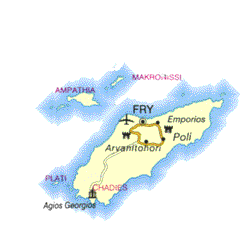
|
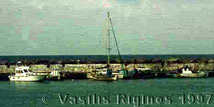
Thetis in Kasos |
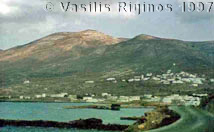
Kasos was well known in antiquity and was mentioned by Homer as a participant of the war on Troy. During the 18th century it reached its peak with a considerable merchant (pirate ?) fleet. It participated in the Greek revolution and was almost totally destroyed by the invading Egyptian fleet in 1824. It has never recovered from that calamity referred to still today as the holocaust.
The island is desolate and very arid. I took a walk to the town where there were very few people in evidence and the whole place was bleak and had a feeling of abandonment.
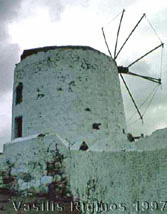
A windmill |
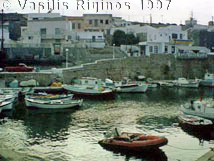
The harbor of Fri |
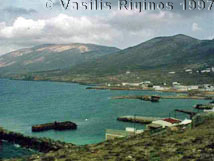
Later I took a shower, as this was the first warm day in a while and I had warm water. It felt good! At night I walked to the town and found the only open restaurant. For a while I was the only customer. The choices were rather limited but the soutzoukakia (meat balls with tomato sauce) with rice that I had were not bad. I found a card phone and called Alice in Washington.
I had forgotten to turn on the Navtex and thus I missed the 8:00 PM broadcast, the next one was at around 2:00 AM. I was contemplating leaving tomorrow for Crete as there was not very much to do in Kasos nor did I like the harbor very much, but I did not want to decide before getting a forecast. So I went to bed leaving the decision for the morning.
Sunday September 21, 1997 Day 45
First thing in the morning, even before making my coffee, I read the weather report that had been received overnight by the Navtex. The situation on the Karpathian and East Cretan Seas was tolerable for this morning with force 5-6 on the Beaufort Scale from the NW but by the evening the wind will be increasing to possible gale levels. Well, staying in Kasos with gale force winds trapped among these fishing boats and their floating lines and the increasing swell may become problematic. The lesser of the two evils was to push on for Crete and find a good shelter near the Sidero promontory, which both pilot books recommend.
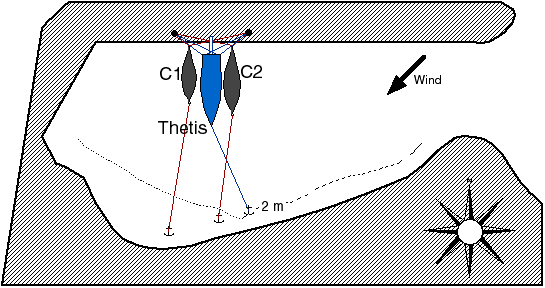
I started the preparation to leave at 6:45. All fishing boats had left the harbor to go fishing except the two on either side of Thetis. These were two of the worst offenders, with their floating lines which extended to more than ¾ of the harbor just below the surface. There was not a soul in the harbor. I planned a whole campaign on how to extricate Thetis from the two boats. I got off the boat, walking on the passarella, and set around a bollard (an iron post on the dock) a very long double line (μπιντένι), took both of its ends back onboard, took all the slack and tied them tight on a cleat. I took all the possible slack from the anchor chain. I loosened the other two stern lines, and got off the boat and I untied them. By this time the passarella was too far removed from the jetty to have any support. I jumped on the hanging passarella and crawled onboard. I removed and lashed down the passarella and started the engine. The idea was to pull the boat forward a few meters while paying out one end of the long shore line but with her stern still held perpendicular to the jetty by the friction on the bollard and thus to clear the floating line under the anchor chain.
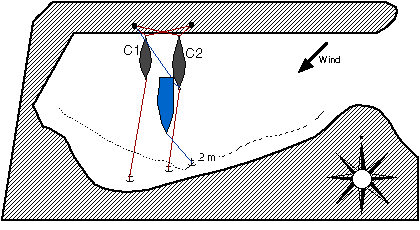
This plan would have worked if my line did not get stuck on the bollard after letting go of its other end. This was caused by the fact that all three boats had their lines on the same bollard, the harbor having only a few of them and no other places to tie a boat line. Fortunately this happened while I was still near to the C2 fishing boat. I tied another line on the Thetis rear cleat, jumped with the other end on fishing boat C2 and tied the line on her bow ring, thus holding Thetis securely. I then walked the length of the fishing boat, jumped ashore, and freed the long line from the bollard. I then jumped back on the fishing boat, untied the second line, pulled it, jumped back on Thetis, and continued with the original maneuver. Success! Off came the anchor without a hitch, and out of the harbor we were.
Then another problem manifested, with the autopilot this time. When I would change the course to the left, the autopilot steered to the right and vise versa, otherwise it worked fine! It took me a few minutes of panic before I could figure this one out. What had happened was this: The new autopilot controller had been set from the factory as a default to power on with its screen illuminated. In my effort to change this default I must have inadvertently set a negative rudder offset. I stopped the boat and, while drifting, I read the manual and set the rudder offset back to zero as it was supposed to be. From that moment on the autopilot performed flawlessly.
With all these delays it was almost 8:30 before we were on our way to Cape Sidero. We motored for 5 M to the North and against the wind to clear the island of Kasos and then we turned WSW toward Sidero. The wind was at 20 to 25 knots from the NW almost against us, and because I was expecting it to increase, we were sailing with the main reefed to the second reef and with a reduced genoa. Later in the morning the wind increased to 30 knots and I further reduced the genoa. Despite the reduced sails and the near head winds, the speedometer showed us doing 6.5 knots, but there must have been a strong contrary current because the ground speed from the GPS was only 4.8 knots. In the early afternoon the wind increased some more, still from the NW, and I reduced the genoa even more. The waves were large but of long wave length. There was considerable spray but thanks to the autopilot I was dry under the spray hood and did not even have to wear the storm gear.
Near Cape Sidero the wind was very gusty with a minimum speed of 35 knots. None of the anchorages suggested by Heikell looked very cozy with this wind. I followed the advise of the Greek Portolanos (pilot) and sailed with great speed South to Via Grande and to Ermoupolis, but again the anchorages were not attractive with this wind. I rolled in the genoa, lowered the main, and motored back north with some difficulty, completely against the wind, to Kouremenos, another highly recommended anchorage according to the Portolanos. Kouremenos, which if translated means the “one with his hair newly cut,” was OK. Not very good, but OK! It was free of waves but what a wind! Two windsurfers were speeding by while I was anchoring outside the little harbor, which was too small and shallow for Thetis to enter. It was 18:50 and we had crossed 49.3 M incoming from Kasos.
I had to anchor as close to the shore [35° 12.9' N 26° 16.2' E] as it was safe in order to stay as protected from the fierce wind as possible. But even at 3 m depth Thetis was some distance from the shore. I wanted to set the second anchor as well, but I was afraid to launch the zodiac as the wind by now was gusting above 43 knots, so I let out more chain and motored to a 2 m depth and let go of the second anchor after which we drifted back to the 3 m depth, secure now with both anchors.
The VHF was receiving Hellas Radio here, so I called Nikos with the Autolink, and he told me that Alice wanted me to call her. I called Alice in Washington. She had received two calls for me: one from a prospective client in California and another from Bernard Kasstan of Eutelsat in France. I called both of them. Alas the prospect is remote and the Eutelsat emergency was already over. Later I cooked pasta with tomato sauce and ate it with relish. The Navtex report calls for gale winds from the NW. By 9:30 I was too tired to keep my eyes open.
Total distance from Samos: 671.2 M, sailing time:128:50 hrs.